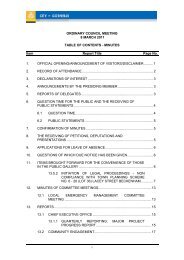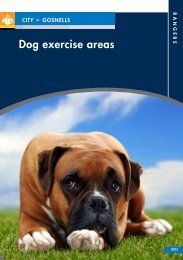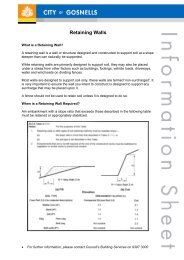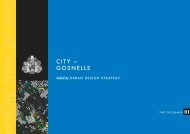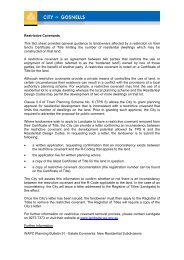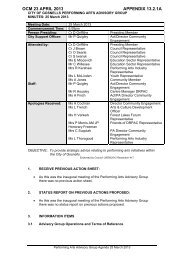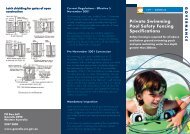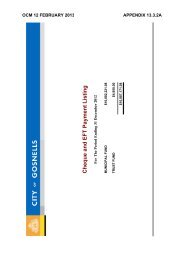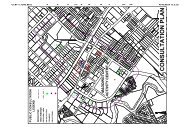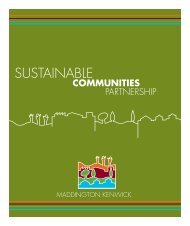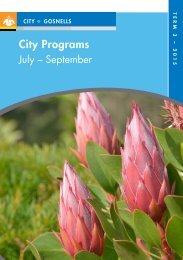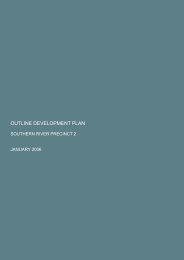Summary - City of Gosnells
Summary - City of Gosnells
Summary - City of Gosnells
Create successful ePaper yourself
Turn your PDF publications into a flip-book with our unique Google optimized e-Paper software.
Conclusions 1017. ConclusionsThe current survey shows that many parts <strong>of</strong> the MKSEA have values <strong>of</strong> national, state and regionalsignificance that are <strong>of</strong>, at least, equivalent importance to the values <strong>of</strong> the local Bush Forever Sites (BFS387 and BFS 53) (Table 7.1). Moreover, some <strong>of</strong> the more significant values (rare flora and vegetation types,TECs and rare wetland types) in the MKSEA are not represented in these Bush Forever Sites. The highconservation significance areas in the MKSEA provide some unique insights into the remarkable story <strong>of</strong>natural history development in the area that complement and enrich the values found in the Bush ForeverSites.Connectivity between areas <strong>of</strong> refugial natural habitat is anticipated to be one <strong>of</strong> the crucial determinants inbiodiversity survival in the future under fluctuating climatic conditions and increasing anthropogenic stresson the biota (DEWHA, 2009). The conservation values <strong>of</strong> the MKSEA and <strong>of</strong> both Bush Forever Sites(particularly BFS 387) are currently subject to levels <strong>of</strong> stress that are unacceptably high, given the nationalsignificance <strong>of</strong> the natural values <strong>of</strong> these areas. The MKSEA is located in an extremely strategic ecologicalarea with regard to the opportunity to increase, via buffer zones and greenways, the connectivity and thus thelong term viability <strong>of</strong> BFS 387, which is generally considered to be the most biodiverse Bush Forever Site inthe Perth Metropolitan Region.The Greater Brixton Street Wetlands and the Clifford Street Bushland include multiple values that are listedunder the Federal Environmental Protection and Biodiversity Conservation Act 1999 and on the Register <strong>of</strong>the National Estate (DEWHA, 2008a). Prior to the current survey there was evidence that the MKSEA alsoincluded nationally significant conservation values (Cardno BSD, 2005; DEC, 2008a, 2008b). The GreaterBrixton Street Wetlands, the Clifford Street Bushland and the MKSEA lands are separated from each otherby cadastral boundaries, but they are an indivisible unit ecologically because they are all part <strong>of</strong> the samelocal-scale hydrogeological system.The Federal EPBC Act is expected to be triggered by proposals for industrial development in the MKSEAdue to the close proximity <strong>of</strong> the MKSEA to the Greater Brixton Street Wetlands and the Clifford StreetBushland and the ecological interdependence <strong>of</strong> the MKSEA and these Bush Forever sites (DEH, 2006). TheEPBC Act will also be triggered by any proposals for industrial development in the MKSEA that threaten toimpact on the nationally significant conservation values contained within the MKSEA (DEH, 2006).In the planning process for the MKSEA, the environmental regulatory authorities (both State and Federal)are anticipated to require that the high conservation value areas <strong>of</strong> the MKSEA (including all CCW andREW wetlands) are conserved and that the high conservation values <strong>of</strong> the MKSEA and both Bush ForeverSites are protected by the additional reservation <strong>of</strong> buffer zones and ecological linkage areas. There are alsopractical limitations involved in developing the MKSEA because most <strong>of</strong> it is wetland underlain by claysediments and the economic and environmental costs <strong>of</strong> overcoming these limitations are high. Typically,development in such catchments, even if native vegetation is not cleared and wetlands are not destroyed,results in negative impacts on water quality and quantity both locally and in the Swan-Canning River system.The current survey concluded (as suggested in the earlier reports to the <strong>City</strong> <strong>of</strong> <strong>Gosnells</strong> by GHD and BSDCardno in 2005) that, given the regulatory, practical and environmental constraints on the site, the area <strong>of</strong> theMKSEA that could be developed without substantial environmental loss or harm is much less than envisagedin the <strong>City</strong> <strong>of</strong> <strong>Gosnells</strong> (2008) MKSEA Concept Plan (Figure 3).On a broader scale, it is evident that all <strong>of</strong> the alluvial fan system associated with the tributaries <strong>of</strong> theCanning River in Wattle Grove, Kenwick and Maddington that remains undeveloped is significant whenassessed against the Criteria for the Register <strong>of</strong> the National Estate (DEWHA, 2008f). This alluvial fanshould, ideally, be viewed as one unit with regard to planning, conservation and management in order todeliver the best outcomes for the important biodiversity, geoheritage and cultural heritage values <strong>of</strong> the area.Three planning and management zones (listed below) are evident within the alluvial fan system, and each <strong>of</strong>these zones should be governed by individual objectives:Tauss, C. and Weston, A.S. (2010). The flora, vegetation and wetlands <strong>of</strong> the Maddington-Kenwick Strategic Employment Area.A survey <strong>of</strong> the rural lands in the vicinity <strong>of</strong> the Greater Brixton Street Wetlands. Report to the <strong>City</strong> <strong>of</strong> <strong>Gosnells</strong>, W.A. Version 18.04.10



